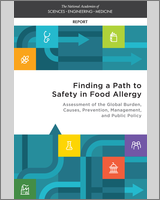NCBI Bookshelf. A service of the National Library of Medicine, National Institutes of Health.
Over the past 20 years, public concerns have grown in response to the apparent rising prevalence of food allergy and related atopic conditions, such as eczema. Although evidence on the true prevalence of food allergy is complicated by insufficient or inconsistent data and studies with variable methodologies, many health care experts who care for patients agree that a real increase in food allergy has occurred and that it is unlikely to be due simply to an increase in awareness and better tools for diagnosis. Many stakeholders are concerned about these increases, including the general public, policy makers, regulatory agencies, the food industry, scientists, clinicians, and especially families of children and young people suffering from food allergy.
At the present time, however, despite a mounting body of data on the prevalence, health consequences, and associated costs of food allergy, this chronic disease has not garnered the level of societal attention that it warrants. Moreover, for patients and families at risk, recommendations and guidelines have not been clear about preventing exposure or the onset of reactions or for managing this disease.
Finding a Path to Safety in Food Allergy examines critical issues related to food allergy, including the prevalence and severity of food allergy and its impact on affected individuals, families, and communities; and current understanding of food allergy as a disease, and in diagnostics, treatments, prevention, and public policy. This report seeks to: clarify the nature of the disease, its causes, and its current management; highlight gaps in knowledge; encourage the implementation of management tools at many levels and among many stakeholders; and delineate a roadmap to safety for those who have, or are at risk of developing, food allergy, as well as for others in society who are responsible for public health.
Contents
- The National Academies of SCIENCES • ENGINEERING • MEDICINE
- COMMITTEE ON FOOD ALLERGIES: GLOBAL BURDEN, CAUSES, TREATMENT, PREVENTION, AND PUBLIC POLICY
- Reviewers
- Preface
- Summary
- 1. Introduction
- 2. Definitions
- 3. Prevalence
- APPROACH TO LITERATURE REVIEW
- DIFFICULTIES IN ASCERTAINING FOOD ALLERGY PREVALENCE
- FOOD ALLERGY PREVALENCE IN THE UNITED STATES AND EUROPE
- PREVALENCE OF FOOD ALLERGY IN OTHER PARTS OF THE WORLD
- PREVALENCE OF FOOD ALLERGY–INDUCED ANAPHYLAXIS
- EVIDENCE THAT THE PREVALENCE OF FOOD ALLERGY IS INCREASING
- OVERALL CONCLUSIONS
- RECOMMENDATIONS
- RESEARCH NEEDS
- REFERENCES
- 4. Assessments, Diagnostic Testing, Disease Monitoring, and Prognosis
- OVERVIEW
- APPROACH TO LITERATURE REVIEW
- REASONS TO INITIATE ASSESSMENTS FOR FOOD ALLERGY
- MECHANISMS OF FOOD ALLERGY IN RELATIONSHIP TO DIAGNOSTIC TESTING
- CURRENTLY AVAILABLE MODALITIES ROUTINELY USED TO DIAGNOSE FOOD ALLERGY
- MODALITIES NOT RECOMMENDED FOR ROUTINE USE
- NONSTANDARDIZED AND UNPROVEN PROCEDURES
- PREDICTION OF SEVERITY OR THRESHOLD OF REACTIONS
- PROGNOSIS AND DISEASE MONITORING
- GENERAL DIAGNOSTIC ALGORITHMS
- TESTING FOR SPECIFIC DISEASE STATES OTHER THAN ANAPHYLAXIS AND ATOPIC DERMATITIS
- COMMON PITFALLS AND MISCONCEPTIONS IN DIAGNOSTICS
- ROLE OF ELICITING FACTORS
- FUTURE DIAGNOSTIC MODALITIES
- OVERALL CONCLUSIONS
- RECOMMENDATIONS
- RESEARCH NEEDS
- REFERENCES
- 5. Potential Genetic and Environmental Determinants of Food Allergy Risk and Possible Prevention Strategies
- 6. Management in the Health Care Setting
- APPROACH TO LITERATURE REVIEW
- ALLERGEN AVOIDANCE AND RECOGNITION OF AND PREPAREDNESS TO TREAT ALLERGIC REACTIONS AND ANAPHYLAXIS
- EDUCATING PATIENTS ABOUT ALLERGEN AVOIDANCE
- ADVICE ON ALLERGEN AVOIDANCE IN VARIOUS SETTINGS OF CONCERN
- EMERGENCY MANAGEMENT OF ALLERGIC REACTIONS
- NUTRITIONAL CONSIDERATIONS
- QUALITY OF LIFE AND MENTAL HEALTH CONSIDERATIONS
- TREATMENT MODALITIES UNDER INVESTIGATION
- OVERALL CONCLUSIONS
- RECOMMENDATIONS
- RESEARCH NEEDS
- REFERENCES
- 7. Management of Packaged Foods
- ELIMINATING ALLERGENS FROM PACKAGED FOODS
- LABELING OF FOOD ALLERGENS
- A NEW PARADIGM: AVOIDING FOOD ALLERGENS AT LEVELS THAT PRESENT RISKS
- A NEW APPROACH TO CREATING A SAFE ENVIRONMENT: THE RISK ASSESSMENT CONCEPT
- DEVELOPING POPULATION THRESHOLDS: MOVING FORWARD
- OVERALL CONCLUSIONS
- RECOMMENDATIONS
- RESEARCH NEEDS
- REFERENCES
- ANNEX 7: DATA INPUTS FOR RISK ASSESSMENT
- REFERENCES
- 8. Managing Food Allergies in Retail, Food Service, Schools, Higher Education, and Travel Settings
- 9. Research Needs
- 10. Final Comments: A Roadmap to Safety
- APPENDIXES
Suggested citation:
National Academies of Sciences, Engineering, and Medicine. 2017. Finding a path to safety in food allergy: Assessment of the global burden, causes, prevention, management, and public policy. Washington, DC: The National Academies Press. doi: 10.17226/23658.
- NLM CatalogRelated NLM Catalog Entries
- Review Food allergy: Epidemiology, pathogenesis, diagnosis, and treatment.[J Allergy Clin Immunol. 2014]Review Food allergy: Epidemiology, pathogenesis, diagnosis, and treatment.Sicherer SH, Sampson HA. J Allergy Clin Immunol. 2014 Feb; 133(2):291-307; quiz 308. Epub 2013 Dec 31.
- Food allergy knowledge, attitudes and beliefs: focus groups of parents, physicians and the general public.[BMC Pediatr. 2008]Food allergy knowledge, attitudes and beliefs: focus groups of parents, physicians and the general public.Gupta RS, Kim JS, Barnathan JA, Amsden LB, Tummala LS, Holl JL. BMC Pediatr. 2008 Sep 19; 8:36. Epub 2008 Sep 19.
- Review Food allergy: psychosocial impact and public policy implications.[Chem Immunol Allergy. 2015]Review Food allergy: psychosocial impact and public policy implications.Sharma HP, Herbert LJ. Chem Immunol Allergy. 2015; 101:221-6. Epub 2015 May 21.
- Food allergy knowledge, attitudes, and beliefs in the United States.[Ann Allergy Asthma Immunol. 2009]Food allergy knowledge, attitudes, and beliefs in the United States.Gupta RS, Kim JS, Springston EE, Smith B, Pongracic JA, Wang X, Holl J. Ann Allergy Asthma Immunol. 2009 Jul; 103(1):43-50.
- Review Heart failure: preventing disease and death worldwide.[ESC Heart Fail. 2014]Review Heart failure: preventing disease and death worldwide.Ponikowski P, Anker SD, AlHabib KF, Cowie MR, Force TL, Hu S, Jaarsma T, Krum H, Rastogi V, Rohde LE, et al. ESC Heart Fail. 2014 Sep; 1(1):4-25.
- Finding a Path to Safety in Food AllergyFinding a Path to Safety in Food Allergy
- cytochrome b (mitochondrion) [Homo sapiens]cytochrome b (mitochondrion) [Homo sapiens]gi|251831119|ref|YP_003024038.1|Protein
Your browsing activity is empty.
Activity recording is turned off.
See more...
